Serendip is an independent site partnering with faculty at multiple colleges and universities around the world. Happy exploring!
Publications from Pregnancy Education Reform

I have invented an organization, Pregnancy Education Reform, and have included two potential publications from the organization. The first is a collection of pdf images of the pages of a pamphlet entitled, “Intersex: An Introductory Guide for Moms-to-be”. And the second is an open letter to primary care providers explaining how to most effectively use the pamphlet and general advice for making prenatal and postnatal care more sensitive to intersex children and their families. Although the organization intends to empower women and their choices, it does take a position against non-medically necessary genitalia normalizing surgeries in its literature.
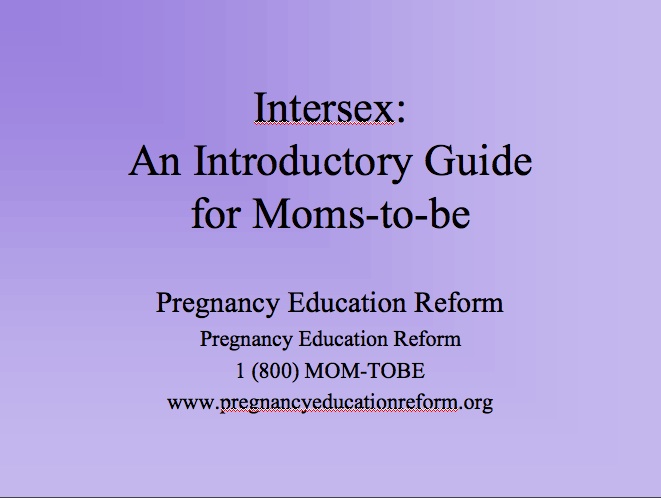
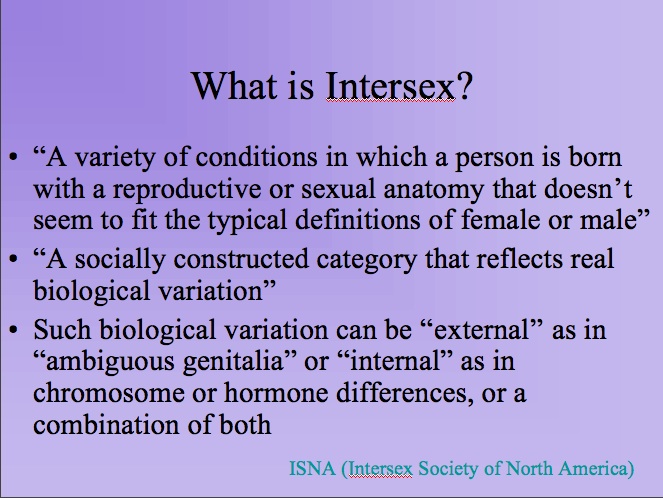
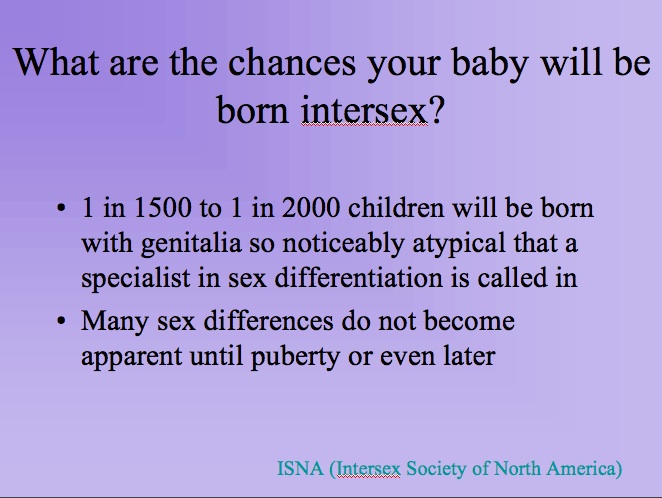
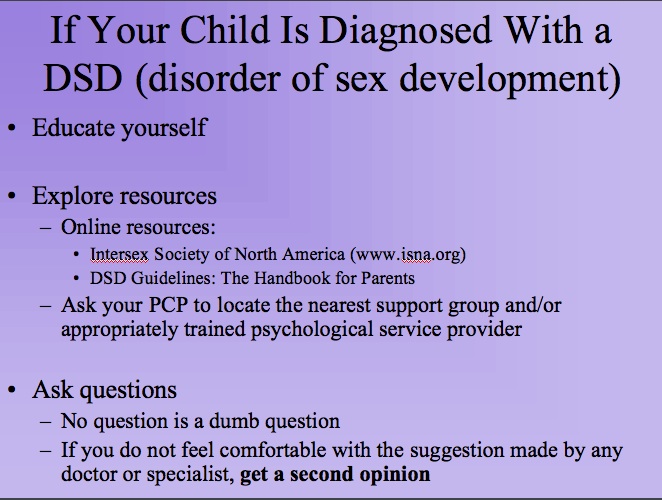
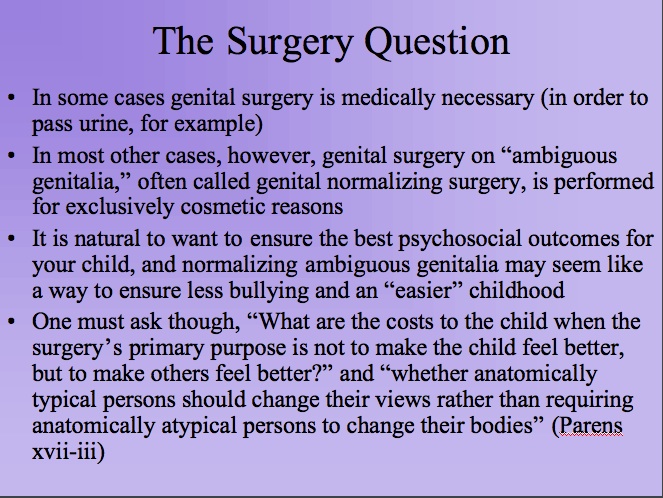
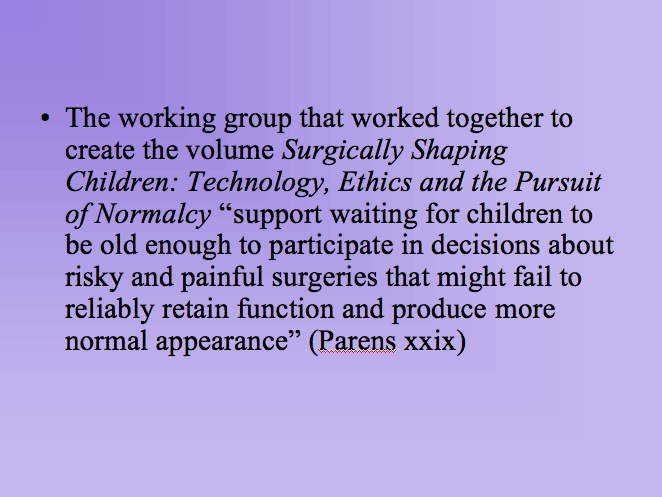
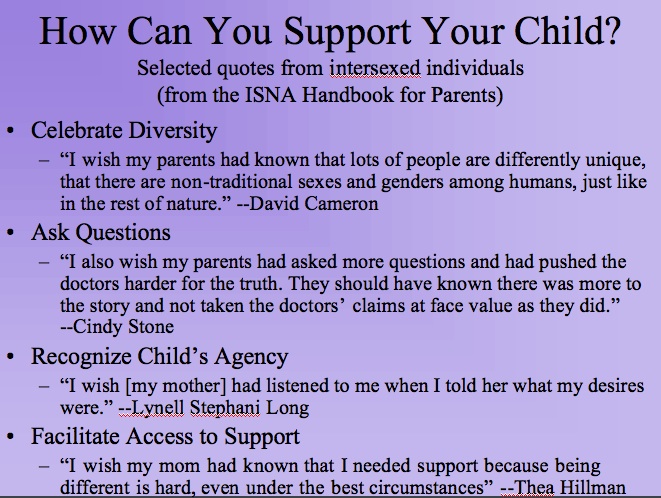
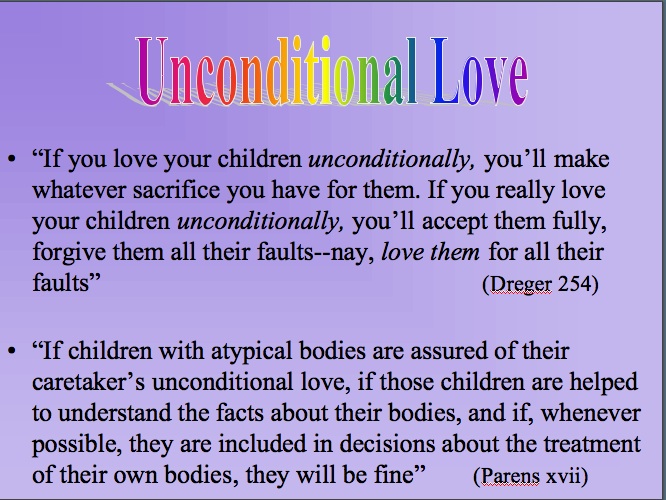
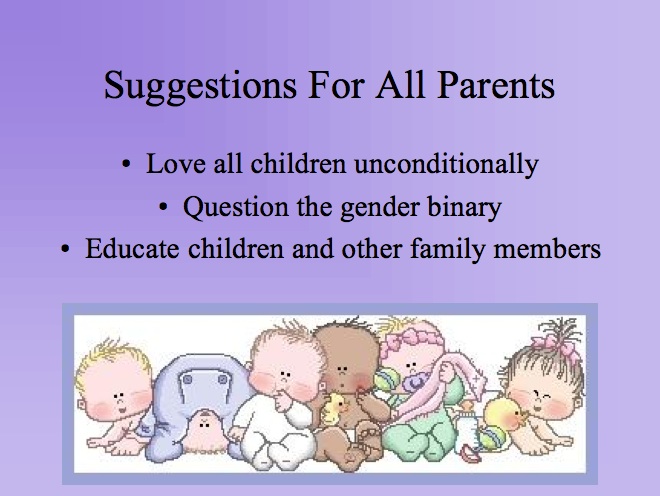
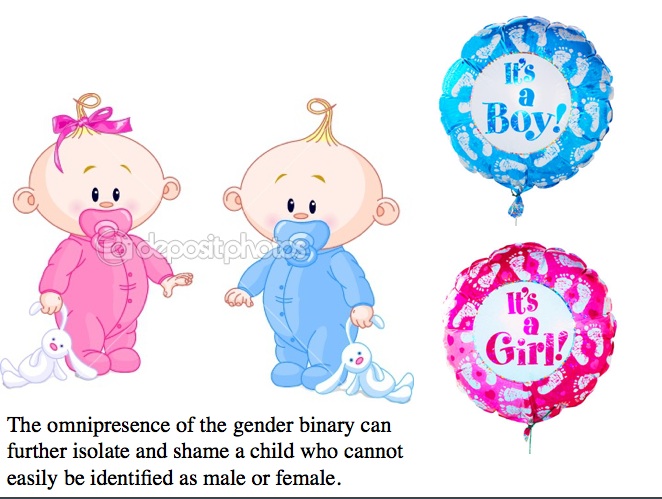
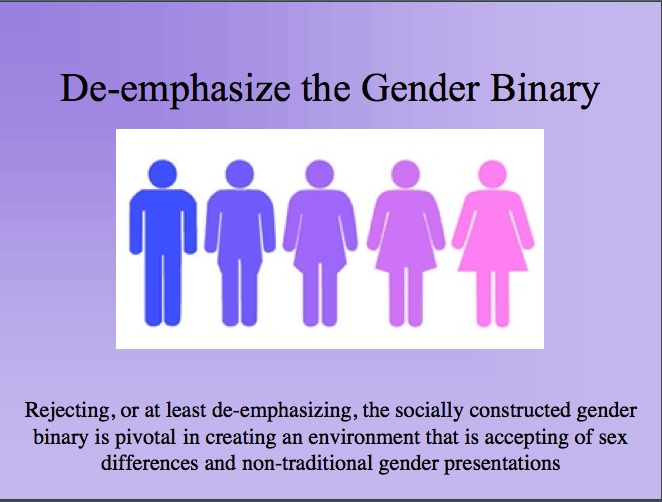
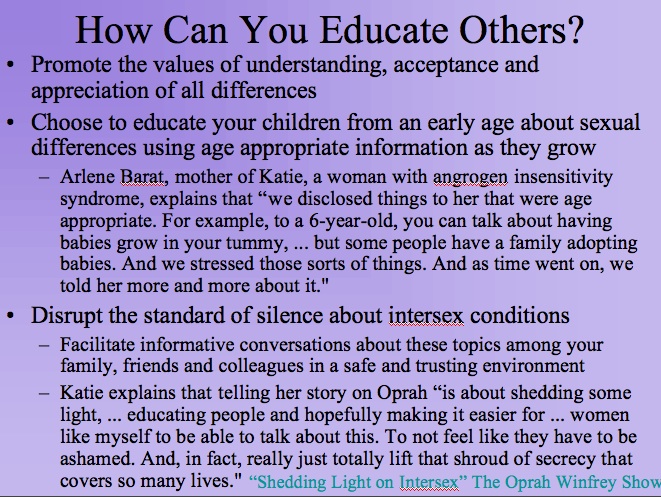
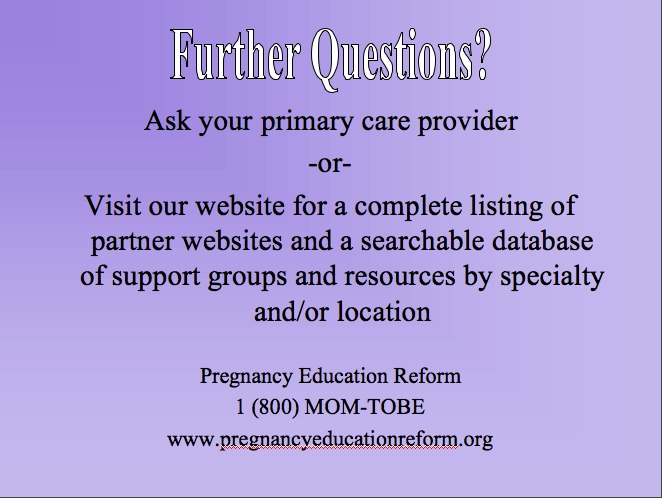
Dear Primary Care Providers,
As the nurses, physicians, doulas, midwives and other primary care providers of prenatal care across the country, we want to thank you for your incredible hard work and dedication. We would like to announce the publication of our new informational pamphlet, “Intersex: An Introductory Guide for Moms-to-be.” We hope that you will incorporate this pamphlet as a teaching tool into the prenatal care for all patients starting immediately.
Contents of the pamphlet:
-A quick overview of intersex
-Suggestions for parents of intersex children based on the testimonies of adults with disorders of sex development (DSD)
-An argument against genitalia normalizing surgeries and the gender binary
-Advice for all parents
-An abbreviated list of resources
We suggest that you distribute the pamphlet during a prenatal visit before the first ultrasound that might show genitalia. Although an ultrasound most likely would not show sufficient detail to diagnose intersex, it is easier to preemptively de-emphasize finding out the sex of the baby and to explain these topics before the soon-to-be mother is too focused on the impending birth of her baby girl or boy. This hopefully will lessen the shock and sense of loss that can be common when parents feel like they “lost the child that they were expecting (that is, the child without a DSD)” as explained in the Handbook for Parents prepared by the Consortium on the Management of Disorders of Sex Development.
We also ask, when time permits, to not only distribute these flyers, but to actually read through the material with the patient. This is a complicated topic that many women will have very little prior exposure to. The sensitive content also may impede timid women from seeking further information on their own. Pregnancy and potential birth outcomes can be very anxiety producing for a mother and our goal is to educate rather than frighten women. As for all prenatal education topics distributed by our organization, if a partner is available we suggest you attempt to involve them in the conversation. This is especially important for this topic because mothers of an intersex child already face difficult choices and an incredibly burden to educate any friends or family members that she chooses to confide in. Additionally, the partner would be one more educated individual about a topic that faces a lack of education and understanding across the board.
We hope this pamphlet will function as a revisionary text to balance out the unquestioning acceptance of the gender binary in mainstream pregnancy websites, magazines and books. By educating all pregnant women, not only those who have already given birth to an intersex child, we hope to see improvements in the lives of intersex children and their parents. We hope the exercise of reading the material together will improve communication between patients and PCPs, which hopefully would strengthen their relationship and lead to better, and more consistently attended, prenatal care appointments and ultimately better birth outcomes.
Lastly, we want to remind you to practice what you preach. Education and reform is not unidirectional and changes can be implemented within your practice as well. A substantive component of this pamphlet emphasizes a questioning of the gender binary. Prenatal care is a great opportunity to challenge our society’s reliance on the gender binary. An institutional push to change the exclamation after birth from “Congratulations! Its a boy!” to “Congratulations! Its a healthy baby!” reflects a better understanding of sex differences and de-genders one of the most principally gendered aspects of child birth. Other changes could include de-emphasizing the sex of all newborn babies by eliminating outward visual representations from the nursery, such as blue and pink clothing or signs. Please visit our website for further suggestions and a blog to discuss what you are already doing in your practice.
Thank you for your time.
Sincerely,
Pregnancy Education Reform
Pregnancy Education Reform
1 (800) MOM-TOBE
www.pregnancyeducationreform.org
Works Cited:
Dumorat Dreger, Alice. "What to Expect When You Have the Child You Weren't Expecting." Surgically Shaping Children: Technology, Ethics, and the Pursuit of Normality. Ed. Erik Parens. Baltimore: Johns Hopkins UP, 2006.254-66. Print.
"Frequently Asked Questions." Intersex Society of North America | A World Free of Shame, Secrecy, and Unwanted Genital Surgery. Intersex Society of North America, 2008. Web. 30 Oct. 2011. <http://www.isna.org/faq>.
“Handbook for Parents.” DSD Guidelines. Consortium on the Management of Disorders of Sex Development. Intersex Society of North America, 25 Mar. 2006. Web. 30 Oct. 2011.
Parens, Erik. “Introduction: Thinking about Surgically Shaping Children.” Surgically Shaping Children: Technology, Ethics, and the Pursuit of Normality. Ed. Erik Parens. Baltimore: Johns Hopkins UP, 2006. 254-66. Print.
"Shedding Light on Intersex." Oprah. The Oprah Winfrey Show, 21 Sept. 2007. Web. 30 Oct. 2011.
Images:
http://api.ning.com/file
http://static3.depositphotos.com/1000792/129/v/450/dep_1290106-Twin-Babies.jpg
http://www.freewebs.com/cradelle/Baby_banner.jpg
http://www.arenaflowers.com/product_image/large/327-its_a_boy_balloon.jpg
http://www.arenaflowers.com/product_image/large/329-its_a_girl_balloon.jpg



Comments
Reforming Education
venn diagram—
Weeks before Karen Barad arrived to invite us to think about “ma(r)king time,” you identified (in one of our small in-class working groups) the importance of time in educating about intersex, by explaining that expectant parents need to learn, long before the birth of their child, about the sorts of things this web event is teaching. The psychological crisis of giving birth to an intersex baby need not be a crisis, if it is prepared for in the way “Pregnancy Education Reform” prepares for it.
So I celebrate and affirm all that you do here, and acknowledge thereby the value and worth of what you’ve termed your anti-utopian/pro-pragmatic approach to activism. Such an approach begins with a good understanding of the complexities and varieties of sexual development, and then disseminates that information in a way that expectant parents can hear. (I’m glad you recognize, too, that there’s a delicate balancing act here: the need to educate rather than frighten.)
Also quite striking here is your acknowledgement that a much larger assault on the insistent binary representation of babies—of blue and pink clothing and signs, for starters—can do much to take the pressure off of what is seldom a medical crisis. De-emphasizing the socially constructed gender binary all along will do much to alleviate what might otherwise seem a fraught situation in the moment of birth, or @ puberty: “it is easier to preemptively de-emphasize finding out the sex of the baby and to explain these topics before the soon-to-be mother is too focused on the impending birth of her baby girl or boy.” I like it, too, that you envision such education as being universal, not aimed only @ women who have already given birth to intersex children.
And so (having affirmed all that!) might I also nudge back a little, regarding one of the problematics here? You quote Parens’ great question about “the costs to the child of surgeries to "make others feel better,” which was for me, when I first read it, a very compelling query. Why indeed, alter the self for others’ comfort? And/but! now that we are all a-swirl, this week, with philosophy on campus, I’m having some trouble so easily separating physiological from psychosocial functioning.
For now we have both Judith Butler and Karen Barad reminding us about the great difficulty of “disentangling” who we are from those with whom we are in relationship. In Chapter 2 of Precarious Life, which we’re reading for this week, for example, Butler suggests that “the attachment to ‘you’ is part of what composes who ‘I’ am”; and throughout her work, Barad asks us to consider the possibility that
'we' have 'intra-actively' written each other ('intra-actively' rather than the usual 'interactively' since writing is not a unidirectional practice of creation that flows from author to page, but rather the practice of writing is an iterative and mutually constitutive working out, and reworking, of 'book' and 'author'….it is precisely because of the passionate yearning for justice enfolded into the core of my being--a passion and a yearning inherited from and actively nurtured by my mother--that I cannot simply say what needs to be said (as if that were a given) and be done with it.”
What to do w/ that theory, which suggests that we can’t do what Katie recommends--“just totally lift that shroud of secrecy”—since well, things are so complicated, and not so easily or simply said?